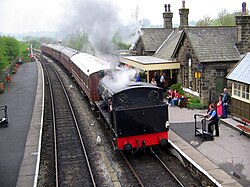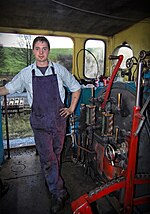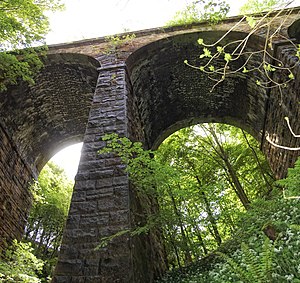Embsay and Bolton Abbey Steam Railway
| Embsay and Bolton Abbey Steam Railway | |
|
Yorkshire | |
|---|---|

| |
| Gauge: | standard |
| No. of stations: | 3 |
| Track: | 4 miles |
| Headquarters: | Embsay |
| Information | |
| Operated by: | Embsay and Bolton Abbey Steam Railway |
The Embsay & Bolton Abbey Steam Railway is a standard gauge heritage railway in Yorkshire, once part of the national rail network but closed in the 1960s, the line was reopened as a heritage railway in 1981.
The route runs through the countryside of the Yorkshire Dales, within the West Riding. The railway has helped and supported the surrounding area (and local economy) to regenerate and provide brand new attractions, boosting both all trade and tourism.
The preserved railway was part of the former Midland Railway route from Skipton to Ilkley. The line was closed by British Railways in 1965 over 15 years before).
The Embsay & Bolton Abbey Steam Railway currently runs for a total distance of 4 miles from Embsay via Draughton Sidings, Holywell and Stoneacre Loop to Bolton Abbey.
The railway has a long-term objective to extend the line in both directions eastwards to the village of Addingham and northwest towards the market town of Skipton (where the line could one day interchange with services on the Airedale Line).
Contents
Overview
The rolling stock on the line consists of 20 ex-industrial locomotives, the oldest of which was built in 1908; three diesel-multiple units; and ten other diesel locomotives. The railway holds annual galas including the popular Diesel Gala and the Harvest of Steam.
Embsay railway station was built in 1888. Bolton Abbey village is named after a nearby ruined 12th century priory, belonging to the Dukes of Devonshire.
The route was formerly part of the Midland Railway line that connected Skipton and Ilkley via Addingham. The line was shut down by British Railways in 1965 and was left to rest in disrepair. Around 14 years later in 1979 a group of volunteers put forward a plan to reopen the line as a preservation route. This plan went ahead and Embsay railway station was refurbished throughout the second half of the 70's and reopened in 1981.
To the west of Embsay station, a run-round loop was built for locomotives to run round. This is near the site of the former Embsay Junction, which was disconnected when the line closed.
By 1987 further extensions brought the line to a newly constructed halt at Holywell and later to Stoneacre Loop. Bolton Abbey railway station finally reopened in 1998, Bringing the current total of over 4 miles in length.
As of 2014, the E&BASR currently plans to extend their services (by way of the nearby 220-yard Haw Bank tunnel) into Skipton (further up the line, a further 2 miles in length - to whom the railway could interchange with services on the Airedale Line), as well as to reconstruct platform 2 at Bolton Abbey station itself, "as part of a possible extension down to Addingham".
Expansion plans
Extension to Addingham and Ilkley
As the original line stretched from the market town of Skipton to the spa town of Ilkley there was a talk of extending the re-opened track to cover the original extent it had before it was closed by British Railways in 1965.
Taking the line to Addingham and re-opening Addingham Station is often mentioned as a potential project but the line's owners have said that they intend to settle down and consolidate the current route, respectively.[1]
Any extension to Addingham would be a huge project, and would involve a near-doubling of the line's current length. Previous extensions have been built in small sections over a long period of time, so re-opening of the line to Addingham would be many years off.
However Sustrans are interested in converting the route into a cycle path, but would provide formation space for a single track allowing any extension to be built.[2]
The Addingham extension could start of as an extension to a possible halt (Wharfe Riverside) to start of with, before Addingham could be thought of officially.
The embankment supporting Addingham railway station, goods yard and depot was removed and replaced in the 1980s with a housing development, with the bridge and abutments over the main road demolished at around the same time.
There are plans to rebuild one of the bridge abutments at the end of the surviving embankment to the north as part of the Addingham Project which also involves constructing a replica LMS style station, goods yard and depot on the extra land next to and at the edge of the embankment.
These would be over the main road from the now defunct former station and goods depot, Funding would have to be made for next couple of 10 to 15 years before any project like this would happen.
Much of the route between Addingham and Ilkley has been re-developed since abandonment. Cuttings have been filled in and Ilkley viaduct was demolished in 1973 (six years before the E&BSR re-opened).
The Skipton platforms at Ilkley station now form the station's car park and there has been significant building development in Ilkley town centre on the former trackbed. Therefore, it is very, very unlikely that this section will ever be reinstated as preserving the whole line between Ilkley and Skipton was considered too expensive.
Connection to Skipton station
There is currently no link between the Embsay and Bolton Abbey line and the Network Rail branch line to Swinden Quarry (the former Yorkshire Dales Railway), the points at this site having been dismantled. Re-instating this link would allow trains to serve Skipton station, and would potentially offer greater access to the railway.[3]
The platforms at Skipton (5 & 6) that served the Ilkley route were made redundant in 1965. If this link were reinstated these platforms would need to be rebuilt as they have been disused for a very long time.
Network Rail has carried out a survey for the reinstatement of the connecting points between the Heritage line at Embsay and the freight line to Rylstone, and the reinstatement of the platforms 5 and 6 at Skipton, costing between £1.1 million and £2.6 million.[3] If funding is made available, then the line could be extended.[4] JMP Consulting has been commissioned to develop a business case for the project[3]
There are also plans for a proposed Wharfe Riverside halt close to the old Lobb Ghyll Viaduct halfway between Bolton Abbey and Addingham stations.
Media appearances
In 1986, whilst footbridgeless at the time, Embsay railway station itself appeared in an episode of the final series of the Yorkshire Television sitcom In Loving Memory as the fictional Oldshaw railway station, in which Ernie Hadfield (Colin Farrell) accidentally led the group on a short cut over the track, resulting in a coffin becoming stuck on the trackbed, which is then crushed by an oncoming train, carrying the deceased from the coffin in front.
The railway was also the filming location of an episode of Emmerdale and has appeared on the BBC Television documentary programme (Great British Railway Journeys).
Stations
- Embsay: Re-opened in 1981, restored to its former LMS condition. The current terminus of the line.
- Draughton (proposed), a halt planned by the LMS and never built
- Holywell Halt, opened in 1987 to view Craven Fault.
- Stoneacre Loop: Run-round loop along the route.
- Bolton Abbey. Current terminus of the line.
Locomotives
Steam
- Operational
- Hunslet Austerity "Norman" built in 1943. (Operational, on loan from SLL)
- Hunslet 16 0-6-0 saddle tank Beatrice No. 2705 built in 1945. (Operational)
- Lancashire and Yorkshire Railway Class 27 0-6-0 No. 52322 (Operational, on loan from the Ribble Steam Railway)
- Hudswell Clarke 0-6-0 Side Tank No. 20 'Jennifer' built in 1942 (On loan from the Llangollen Railway to work Santa Specials)
- Undergoing overhaul or restoration
- Andrew Barclay 0-4-0ST No 22 built in 1952
- Hunslet 0-6-0ST No 8 "Warspite" built in 1952
- Peckett 0-4-0ST No 1159 "Annie" built in 1908
- Hunslet 0-6-0ST No 1440 "Airedale" built in 1923
- Hunslet 0-6-0ST No S112 "Revenge". built in 1942
- Hunslet 0-6-0ST No 3715 S121 "Primrose" built in 1952
- Hudswell Clarke 0-6-0ST No 1208 " Illingworth " built in 1916
- Sentinel 0-4-0 No 7232 "Ann" built in 1927
- Stored
- Hunslet 0-6-0ST No 1 "N.C.B. Monckton No.1" built in 1953
- Hudswell Clarke 0-6-0T No 1450 "Thomas" built in 1922
- Hudswell Clark 0-6-0T No 140 built in 1948
- Yorkshire Engine Company 0-4-0ST No 1 "York" built in 1949
- RSH 0-4-0ST No 2
- Hudswell Clarke 0-6-0ST No 5 "Slough Estates" built in 1939
- Hunslet 0-6-0ST No 69 built in 1953
- Hunslet 0-6-0ST No S134 "Wheldale" built in 1944
Diesel
- Operational
- Ruston & Hornsby 4wDM No 887
- Andrew Barclay 0-4-0DM No 2 "Meaford"
- Vulcan Drewry Class 04 0-6-0 No D2203
- BR 0-6-0 Class 08 No 08773
- BR A1A-A1A Class 31 No 31119
- Undergoing repair, overhaul or restoration
- BR Class 37 37294
- Fowler 0-4-0 No 4100003 "H.W. Robinson"
- BR 0-6-0 Class 14 No D9513
- BR 0-6-0 British Rail Class 08 No 08054
- Stored
- Fowler 0-4-0 No 4200003
- Baguley Drewry 4w "The Bug/Clockwork Orange"
- Hudswell Clarke 0-6-0 No 36
Vintage carriages
- MR Corridor Third No 238 built in 1922
- MR Corridor Third No 241 built in 1922
- ECJS Clerestory (Body:now on Gresley) No 189
- GER 6w Family Saloon No 8 built in 1877.
- GER 6w Saloon No 14 built in 1899.
- GER 6w Family Saloon No 37 built in 1897.
- GNSR 6w Saloon No 34 built in 1896.
- LYR Directors Saloon No 1 built in 1906.
- LNWR Directors Saloon No 1318, built in 1913.
- LSWR Queen Victoria's Saloon No ?.
Outside links
| ("Wikimedia Commons" has material about Embsay and Bolton Abbey Steam Railway) |
References
- ↑ Embsay & Bolton Abbey Steam Railway History
- ↑ Bolton Abbey to Addingham
- ↑ 3.0 3.1 3.2 "Formal study planned for Bolton Abbey-Skipton link". Rail (647): p. 15. 2010-06-30.
- ↑ Today's Railways (86).

